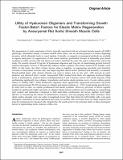| dc.contributor.author | Kothapalli, Chandrasekhar R. | |
| dc.contributor.author | Gacchina, Carmen E. | |
| dc.contributor.author | Ramamurthi, Anand | |
| dc.date.accessioned | 2011-07-20T19:05:08Z | |
| dc.date.available | 2011-07-20T19:05:08Z | |
| dc.date.issued | 2009-11 | |
| dc.date.submitted | 2008-10 | |
| dc.identifier.issn | 1937-3341 | |
| dc.identifier.issn | 1937-335X | |
| dc.identifier.uri | http://hdl.handle.net/1721.1/64934 | |
| dc.description.abstract | The progression of aortic aneurysms (AAs) is typically associated with an activated smooth muscle cell (SMC) phenotype, diminished density of mature medial elastic fibers, and an elevated presence of matrix-degrading enzymes, which ultimately leads to vessel rupture. Currently, no surgical or nonsurgical methods are available to regress aneurysms via regeneration of new elastic matrices, particularly because of inherently poor elastin synthesis by adult vascular cells and absence of tools to stimulate the same. We seek to address this void in this study. We recently showed 0.2 [mu]g/mL of hyaluronan oligomers and 1 ng/mL of transforming growth factor-[Beta]1 (termed elastogenic factors) to dramatically enhance elastin synthesis and matrix formation by healthy aortic SMCs. In this study, the effect of these factors, alone or together, on suppressing procalcific and elastolytic activities of aneurysmal vascular cells, and improving their elastin matrix synthesis and assembly is examined. Periadventitial injury with calcium chloride was used to induce AAs in rats, and 45% increase in aortic diameter was observed after 4 weeks. Aneurysmal SMCs isolated from these AA segments produced higher levels of inflammatory markers matrix metalloproteinases-2 and 9 elastase activity and calcific deposits, while synthesizing significantly less collagen, tropoelastin, and matrix elastin proteins over a 3-week culture period, relative to healthy SMCs. While hyaluronan oligomers alone significantly suppressed aneurysmal cell proliferation and promoted 20–50% increases in collagen and elastin synthesis (p < 0.01), transforming growth factor-β1 alone had no effect on cellular proliferation and elastin synthesis. However, provision of factors together resulted in significantly higher amounts of collagen/elastin protein synthesis and crosslinking, by upregulating lysyl oxidase and desmosine. Compared to their individual contributions, the factors together were highly effective in minimizing the release of inflammatory enzymes, and encouraging elastic fiber formation. Since elastic matrix amounts were one order of magnitude lower than that observed with healthy cells, even upon elastogenic stimulation at doses optimized previously for healthy cells, increased doses are likely required and must be reoptimized for diseased cells. Despite this, the results point to the potential utility of these elastogenic factors in regenerating elastic matrices within AAs. | en_US |
| dc.description.sponsorship | American Heart Association (SDG 0335085N) | en_US |
| dc.description.sponsorship | National Institutes of Health (U.S.) (C06RR018823) | en_US |
| dc.description.sponsorship | National Institutes of Health (U.S.) (EB006078-01A1) | en_US |
| dc.language.iso | en_US | |
| dc.publisher | Mary Ann Liebert, Inc. | en_US |
| dc.relation.isversionof | http://dx.doi.org/10.1089/ten.tea.2008.0593 | en_US |
| dc.rights | Article is made available in accordance with the publisher's policy and may be subject to US copyright law. Please refer to the publisher's site for terms of use. | en_US |
| dc.source | Mary Ann Liebert | en_US |
| dc.title | Utility of Hyaluronan Oligomers and Transforming Growth Factor-Beta1 Factors for Elastic Matrix Regeneration by Aneurysmal Rat Aortic Smooth Muscle Cells | en_US |
| dc.type | Article | en_US |
| dc.identifier.citation | Kothapalli, Chandrasekhar R., Carmen E. Gacchina, and Anand Ramamurthi. “Utility of Hyaluronan Oligomers and Transforming Growth Factor-Beta1 Factors for Elastic Matrix Regeneration by Aneurysmal Rat Aortic Smooth Muscle Cells.” Tissue Engineering Part A 15.11 (2009) : 3247-3260.© Mary Ann Liebert, Inc. | en_US |
| dc.contributor.department | Massachusetts Institute of Technology. Department of Biological Engineering | en_US |
| dc.contributor.approver | Kothapalli, Chandrasekhar R. | |
| dc.contributor.mitauthor | Kothapalli, Chandrasekhar R. | |
| dc.relation.journal | Tissue Engineering. Part A | en_US |
| dc.eprint.version | Final published version | en_US |
| dc.type.uri | http://purl.org/eprint/type/JournalArticle | en_US |
| eprint.status | http://purl.org/eprint/status/PeerReviewed | en_US |
| dspace.orderedauthors | Kothapalli, Chandrasekhar R.; Gacchina, Carmen E.; Ramamurthi, Anand | en |
| mit.license | PUBLISHER_POLICY | en_US |
| mit.metadata.status | Complete | |
